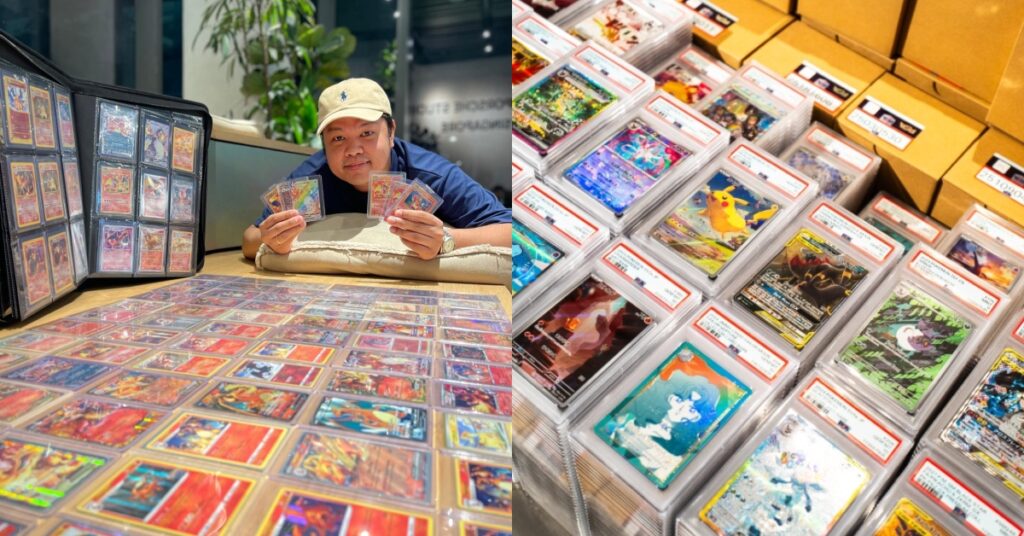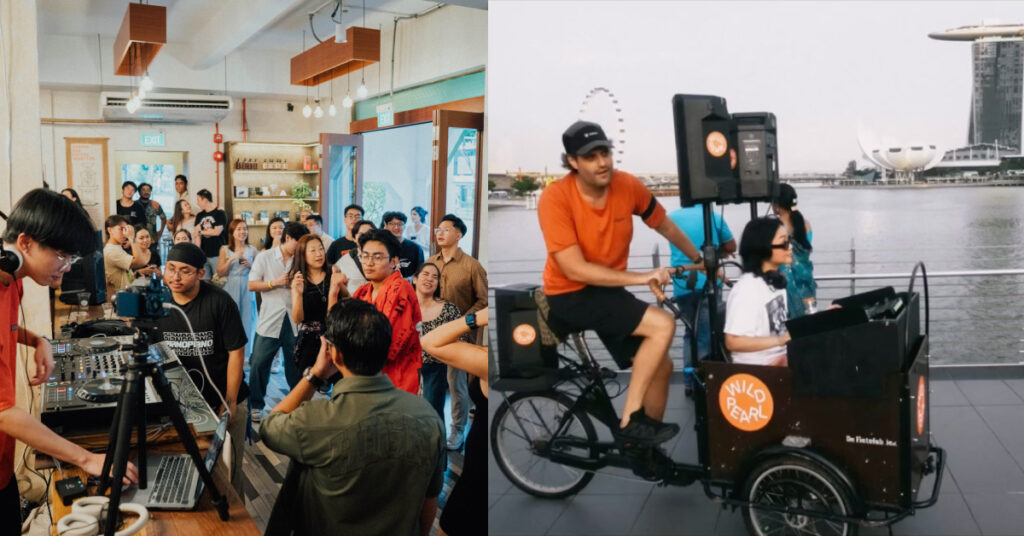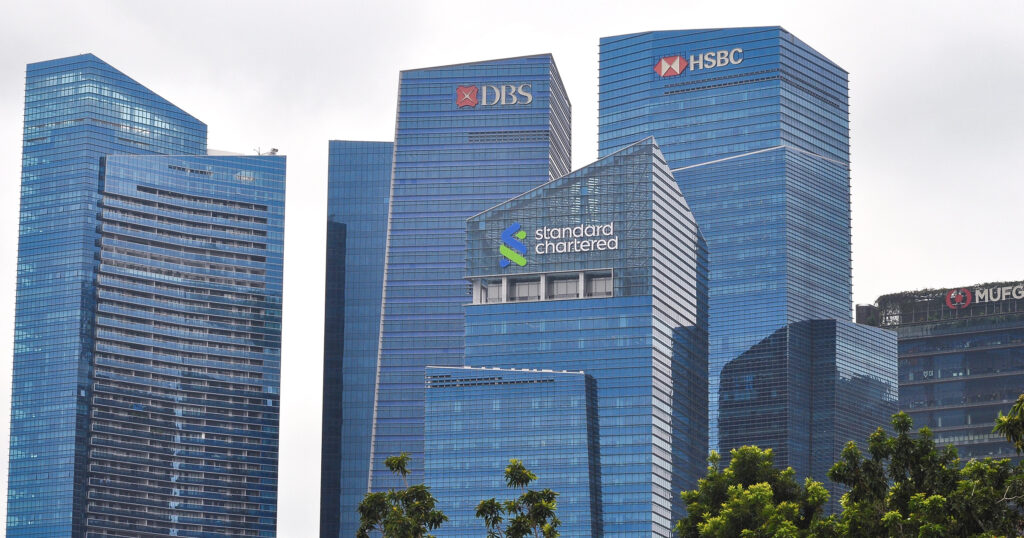This article originally appeared on Vulcan Post.
Mention quaint, indie and avant-garde, and the little shops of Haji Lane immediately spring to mind. In recent years, the narrow alley has gained a reputation for its eclectic collection of stores, selling anything from Scandinavian-inspired cushions to organic bamboo fibre clothes.
You’ll feel like you’re entering a different world as soon as you step foot in the alley; in stark contrast to the gleaming modernity of nearby Bugis Junction, everything here, from the Peranakan architecture to the vintage letterboxes that dot the shopfronts, sings of old-world charm.

A trip to Haji Lane is all about the experience. Even if you leave without buying anything, you’ll likely be satisfied anyway — for me, the fun vibe and picturesque sights are usually enough to make for an enjoyable time there. (The fact that practically any photo you take in Haji Lane is Instagram-worthy doesn’t hurt as well.)
Shopowners call cheerful greetings when you enter, and here and there you might spot a cat lounging in a wicker chair. And true to its olden-day shophouse facades, the small community that’s setting up shop there is known to be a close-knit, supportive one — they’ve even got a Haji Lane Facebook group where shopowners can post about their upcoming events.
There’s a lot that’s already been said about the wonders of Haji Lane, and personally, I could gush on about its clothes shops and cafés all day. But while I am planning to do just that, it’s also worth taking a trip down memory lane, to a time before Singapore’s ultimate hipster enclave became cool — and following that, to explore whether the old-school appeal we know and love is truly a remnant of its rich history. The answer might surprise you.
History

The shophouses of Haji Lane have a history no less interesting than the stores they house now. In the 60s and 70s, the area provided lodging for poor Malay families, and also gave shelter to pilgrims on their annual pilgrimage to Mecca. Incidentally, that’s where the name of the street has its roots — ‘Haji’ is the Malay word for a Muslim man who’s completed a pilgrimage to Mecca.
It’s pretty apt that the first shop which took on the monumental task of reviving the area’s nightlife scene was a Middle Eastern-style café. Café le Caire, an Arabic hookah restaurant which started up in 2001, was then the only establishment in Kampong Glam willing to open at night and on Sundays. According to the café owner, Ameen Talib:
“The whole Haji Lane area was totally dead…There were basically just a lot of empty shop houses. The ones that were occupied were used as storage spaces.”
(Source: New York Times)

Sadly, Café le Caire closed its doors just two months ago. But over the past 14 years, Talib has had the joy of seeing the once-lifeless area grow into a place with one of the most vibrant nightlife scenes in Singapore. As dusk falls, Haji Lane comes alive, with animated laughter and slow music spilling from dimly-lit bars and cafés.
If you’ve visited Singapore’s narrowest street at night, you might remember weaving around the alfresco diners and dodging the occasional car. It’s testament to how lively the street has become that in 2013, temporary road closures to keep the lane car-free on Friday nights and weekends began.

Haji Lane by day is no slouch either. In the afternoon, the street is usually filled with fashionistas looking for exotic products of the kind impossible to find in conventional shopping malls.
The lane’s claim to bohemian fame began when Japanese fashion label Comme des Garçons set up a ‘guerrilla’ store in 2005 — a popup lasting only a year, with minimal expense on things like interior design. These are trademarks of a popup store that we might recognise today, but back then, they were utterly revolutionary.
To cut a long story short, Singaporeans loved it. Soon after, a wave of avant-garde fashion stores followed, kicking off Haji Lane’s current repute as Singapore’s locus of offbeat eccentricity.

It’s an incredible transformation for a lane that pretty much languished, forgotten, just a decade ago. Now, while the narrow, unmarked entrance to this little alley remains as unassuming as ever, you can hardly call Haji Lane the hidden gem of Singapore anymore.
Also Read: Steady, Silent, And Deadly: Inside Singapore’s Hidden Gem Startup, ShopBack
What Makes Haji Lane Different
Don’t browse the shops at Haji Lane with conventional expectations, or you might just miss out on a few gems. My friend and I learnt that the last time we visited when, circling the area with hungry bellies, we passed up a shuttered storefront. Strangely enough, the walkway outside was lined with chairs and tables, and there was a queue waiting to be seated; we surmised that it was a restaurant. But there was no food in sight, so we moved on.
Later, we realised that the queue we saw was for the popular I AM café across the road, which we had also passed up for having no available seats at a quick glance — turns out there were plenty opposite. It was such a pity, because it’s still one of my foodie goals to try their rainbow crepe cake.


Confusing layout aside, the narrow, blink-and-you’ll-miss-it shopfronts — stemming from a time when property owners paid taxes according to the number of windows they had — can make the alley unusually difficult to navigate.
It also doesn’t help that, in keeping with the artsy vibe of the place, a lot of shops opt for tasteful, understated store names over the usual blaring storefronts, or let distinctive décor speak for themselves — which means if you’re searching for particular shops, you’ll sometimes have to play spot-the-shop-name.


Of course, for experienced visitors, all of this only adds to the whimsical, rustic charm of Haji Lane. If you’ve only been there once or twice, you might have missed out on some great finds — I’ll be highlighting some fantastic shops that are definitely worth a trip down.
For me, one key aspect which makes the stores at Haji Lane stand out is that often, they redefine our basic idea of a shop. Many shops that call Haji Lane home are enthralling because they have a rare fluidity to their concept. If you think about it, we typically group stores in major categories: clothes, jewellery, furniture and so on. But here, you’ll find a lot of fusion shops that defy classification.

Shop Wonderland is a café, a florist, and a mini studio all rolled in one. The first floor, also known as The Pantry, sells quirky food items like flavoured sodas in medicine bottles and pastries.


The entire Shop Wonderland space is floral and botanical-inspired, with foliage forming much of the decor. Upstairs, you’ll find a retail shop selling dresses, flowers, and other homeware.


A Thousand Tales is a furniture store selling Scandinavian-sourced pieces. But looks are deceiving, as the furniture shop only occupies the first storey of the shophouse; the second storey houses Cafe Fables & Bar Stories (below).

By day, the second floor operates as a cafe, Cafe Fables. By night, it transforms into a funky, open-concept bar, Bar Stories.

The Nail Social isn’t just a place to do your nails — the ‘social’ in its name reflects both its status as a semi-café offering desserts and drinks, and its socially-conscious mission of training and hiring women from disadvantaged backgrounds.

Maison Ikkoku is a boutique café known for its freshly brewed coffee and signature Mizuki bun. But that’s just the first level of the three-storey shophouse.



If you go up to the second storey, you can browse through some indie menswear labels imported from Japan, France, and more. And finally, above this menswear boutique sits an alfresco cocktail bar with an inhouse mixologist.

No, it’s not a clothing shop that also sells salad, although at this point that wouldn’t be too surprising. SaladShop is a store for both you and your home — it sells fashion and home accessories in its bright two-story space.
Even when artisanal coffee and fashion labels aren’t blurring boundaries in new and unexpected ways, a café is never just a plain old café in Haji Lane. It’s as though everyone there must pass a quirk test before being allowed to set up shop. It might be an unusual niche, like Pita Bakery (29 Bali Lane) and its made-from-scratch Mediterranean pita bread…

And if the menu isn’t out-of-the-box, the marriage of food and ambience probably is. It might be striking, edgy furnishings like the street art outside the Blu Jaz Café (11 Bali Lane)…

…or thought-provoking décor with a story, such as CAD Café (23 Haji Lane) and its showcased works from local and upcoming artists, as well as Elffin & Elffin (29 Haji Lane), a dessert café with an art gallery and cosy area on the upper floor.


It’s not just the hipster cafés that’re attracting patrons, of course — Haji Lane’s celebrated fashion scene deserves more than just a mention as well. As you might expect, the couture there is just as bohemian and versatile, and browsing through them makes for an interesting pastime on a sleepy Sunday afternoon.
Most of the labels found there fall into two broad categories. First, there’re the small local boutiques — Haji Lane has gained a reputation for being a place where budding Singaporean designers and entrepreneurs can establish themselves.
Also Read: Top 10 Online Shopping Sites In Singapore You Need To Bookmark Now

One of the alley’s most well-known local boutiques is Modparade. From on an online label started up by Fernnice Wong and her mum, Modparade has since evolved into a brick-and-mortar store renowned for their exclusivity — each curated outfit has only a maximum of three pieces.

You wouldn’t associate bamboo with clothing, much less softness, but Singapore’s pioneer in eco-fashion Zhai Eco Collection is making it happen. Zhai’s original, organic bamboo clothing has been said to be “like liquid silk” and comes in muted, classic tones, making them perfect for both casual and office wear.
Soon Lee (73 Haji Lane), meaning ‘plain sailing‘, is a women’s fashion shop that carries clothing from local designers, as well as from countries as varied as Hong Kong and New York. And thus far, it looks like the seas are calm for the popular boutique. (Image Credit: sg.asia-city.com)
Speaking of fashion from abroad, Soon Lee‘s diversified concept is actually a great reflection of Haji Lane itself, where boutiques stocking homegrown fashion stand cheek by jowl with collections of indie labels from all over the world.

From water buffalo leather bags to Geometry Harem Flow pants, The Alternative Store is cornering the market on zen, eccentric fashion. Their products — which also include crystals and incense — are Himalayan-inspired and hand-picked from India, Nepal and Thailand.

If you’d like some handcrafted Colombian bags to go with that funky pair of harem pants from The Alternative Store, Kolombiana has got you covered. Woven through age-old techniques by the Wayuu, an indigenous tribe in Colombia, you won’t find anything like their colorful accessories elsewhere in Singapore.

Time After Time is one of the newest additions to Haji Lane. This little jewel box of a shop stocks one-of-a-kind, handcrafted accessories and vintage dresses from Japan, Thailand and Korea.
Time After Time was founded by two sisters in their thirties, Sandra and Michelle Chia, in a leap of faith. And the fashion scene in Haji Lane is all the richer for their venture. (Image Credit: AsiaOne)
What might not be apparent from the alley’s quirky appearance is the question of whether the folks at Haji Lane can maintain their status as a quaint hipster enclave. As with any popular location, the lane’s increasingly fashionable reputation comes with inherent downsides: while some shopkeepers claim that competition isn’t a problem as “each of them has something different to offer”, the area’s notoriously high rents and swift turnover rates may reveal otherwise. As Jo Soh, designer of local label Hansel, puts it:
“In cities like London, they have affordable quarters where designers can set up shop to sell their creations… Haji Lane used to be that kind of enclave but the rents have shot up and out of reach of many designers.”

Currently, Haji Lane is still well-loved by shopowners and visitors alike for its unconventionality; for founder of Mondays Off (76 Haji Lane) Leyna Poh, the alley is “a place where I could choose the hours“. (As the name of her shop implies, Mondays Off is open only from Tuesdays to Sundays.)
In a city where so much of the urban landscape can seem homogenous, the allure of Haji Lane is its warm embracing of idiosyncrasy and individuality. But as pointed out, this indie, offbeat vibe may not be possible to preserve as space there becomes more and more hotly contested, deterring hopeful entrepreneurs. Let’s hope that what makes Haji Lane different continues to work its magic, at least for a while.
Between Conservation and Urbanisation

The thought that Haji Lane might lose its rustic magic is pretty depressing. But for all its celebrated old-world charm, here’s a curious thing you might not have realised: the Haji Lane we now know and love has had to overcome quite a fair bit to retain its current facade.
No incident better illustrates this than the uproar caused by the Urban Redevelopment Authority over street art on Haji Lane’s conserved shophouses. Around three years ago, some of the graffiti art for which Haji Lane is so famous was red-flagged by the URA for not meeting the traditional colour schemes allocated to the area’s preserved shophouses.
‘According to new colour guidelines released on the URA’s website in January, shophouse owners are “encouraged to use traditional colour schemes in the painting of your building to retain its unique heritage character.”
Traditionally, the base colour for shophouses is that of a pastel hue. Stronger colours should be used only for the purpose of highlighting selected features or decorative ornamentations, the guidelines said.’
(Source: AsiaOne News, September 2012)
From more recent trips to Haji Lane, you would already know that the alley’s striking, colourful street art was not, in fact, forced to be painted over eventually. Instead, the URA decided to allow graffiti art to be kept on a case-by-case basis, later conceding that guidelines for shop murals were to be kept “very broad, as it is not practical to prescribe guidelines for artistic creativity“.
Also Read: Apps I Live By: Owner And Artist Behind AiClay, Jocelyn


All’s well that ends well? It’s an incident we’ve all but forgotten now, but it raises an oft-overlooked point: that despite Haji Lane’s renowned quaintness, modernity is constantly infringing on that which is truly olde-worlde. It’s hard to decide whether the allure of the enclave lies in its fashionable edginess or its sleepy backwater air, and therein lies the conflict that caused the URA furore.
The fact that Haji Lane has one foot in two worlds — conservation and urbanisation — becomes particularly striking if you compare it with its neighbouring alley, Arab Street. The lane’s revival, while great news for the hipsters among us, is arguably something of an anomaly in Kampong Glam.

We mentioned earlier that Haji Lane’s name has its roots in the Malay word “haji” — a heritage that isn’t particularly evident when you’re weaving through the alley’s collection of fashionable boutiques and cafés. One local blogger expresses it well by pointing out, “Most of the youths [who visit Haji Lane] are generally unaware of the place’s historical significance and value to the Malay community. To them, Haji Lane is merely a place where they shop and hang out with their friends.”
Contrast this with Arab Street, which remains a key Muslim centre packed with Muslim restaurants, shops selling traditional wares like rattan and spices, and travel agents specialising in the needs of Muslim pilgrims headed to Mecca.

That’s not to say that that’s entirely a good thing for Arab Street, however. In June last year, My Paper ran an interesting feature comparing Haji Lane and Arab Street. The two adjacent lanes could not be more different; not just in terms of fidelity to their history, but profitability as well:
“…one is a bustling hive of activity, with cafés and boutiques attracting the young and hip. The other is a sleepy stretch of mostly textile and carpet shops struggling to stay relevant.
In Haji Lane, shops have seen their business grow up to 15 per cent year on year, with some even looking to expand. However, shops along Arab Street are feeling the squeeze from high rentals and low customer traffic.”
(Source: My Paper)
Of course, the fact that parts of the past must be relegated for the sake of prosperity isn’t exactly a new concept in Singapore — that’s what our city-state has been doing to stay on the cutting edge for the past 50 years, after all. Haji Lane is interesting because it showcases exactly the kind of dilemma between staying true to the past and the lure of the future that many other parts of Singapore faced decades ago.
Not All Doom And Gloom

So that’s the picture of Haji Lane that we’ve drawn for you: great chillout place for café hoppers and fashion lovers, historical site of Singapore’s Malay settlement, and alley with a quaint charm that may or may not be truly a remnant of its past. But as the heading above suggests, it’s not all doom and gloom as Haji Lane becomes increasingly chic and rents soar. The rambling alley remains a vibrantly indie haven for many of us, and as a result, it is developing an identity all of its own.
A number of solutions have been suggested in order to merge Haji Lane’s past and present cultural significances, most relating to the enclave’s distinctive architecture. It makes sense that alongside its spectacular street murals and quirky sights such as the Audrey Hepburn sketch outside fashion shop Mod Parade, space might be made to visually represent the alley’s historical roots as well.
“I propose to use Haji Lane as a sort of “memory lane”. Simple-looking signboards can be hung along the lane, with each signboard telling people more about what Haji Lane used to be. For example, one signboard could say “This is where Malay families used to live”.”
(Source: Friendly Giant)

And as Spaces for Identity points out, a fusion of history with the avant-garde may not “be as impossible as it seems”:
“This is a graffiti artwork on a wall, part of the exterior décor for an eatery. It clearly contains Javanese elements, and more of this is what could perhaps steer preservation in the right direction. Preservation does not mean putting a complete halt to progress — it means moving forward with our historical and cultural roots in mind.”
(Source: Spaces for Identity)

In a city where the neat malls lining our MRT tracks differ little from one another, Haji Lane is fast carving out a special place in the hearts of Singaporeans. The fact that the alley has managed to secure a popular reputation as both quaint and avant-garde — two descriptors that are by definition contradictory — makes us a lot more hopeful that Haji Lane will be able to stay relevant while preserving its old-world heritage.
And for the foreseeable future, the Haji Lane experience will remain as it has always been — enthralling, different and continually surprising.
Also Read: Short Term Rentals: Breathing New Life Into Singapore’s Jaded Hotel Industry











